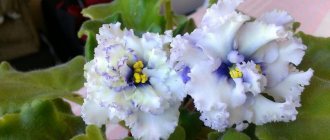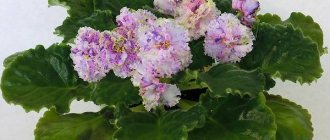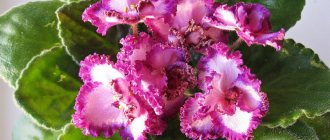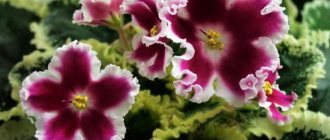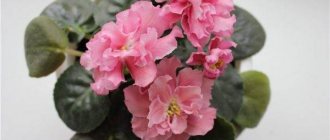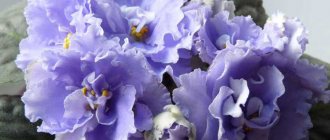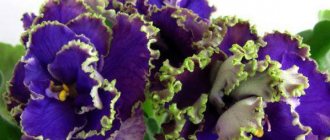Violet Frosty Frolic (L. Lyon), or Frosty Frolic
This variety is an officially registered sport from the Frozen in Time variety by Sorano.
Frosty Frolic and Frozen in Time.
From time to time, Frozen in Time turns into Frosty Frolic on its own due to exposure to high temperatures or with age. Sometimes Frost Mischief starts to lighten up and resembles Frozen in Time quite a lot.
Frozen in Time shouldn't have any lavender on the petals, and Frosty Frolic has too much white. It is often very difficult to establish the boundaries between two varieties.
also a chimeric sport from the Frosty Mischief variety. It's called Frosty Morning. Also in 2006, the Ko`s Green Dragonfly sport was registered, but it is identical to the previous one.
The photo below shows options for chimeric sports.
Rosette standard , leaves are large, medium green in color with white variegation like Tommy Lowe. The leaf plate has a quilted edge.
The flower is a pansy , slightly cup-shaped. The petals are lavender-colored with a wide green border. It is worth noting that the shade of the border is a little dirty, it can even be called swamp. This combination of colors gives the variety a special charm.
A distinctive feature of this variety is its abundant and long-lasting flowering . It always blooms with a lush, beautiful bouquet, which in cool conditions can remain fresh for up to six months.
Often the period of continuous flowering lasts for a year. At low temperatures, a darker green border begins to appear at the edges of the petals.
Frosty Frolic is considered one of the record holders for the longest flowering time.
Important! The shade of the petals is maintained regardless of temperature conditions.
Violet Rob's Mango Mongo or Robz Mango Mongo
The variety belongs to semi-miniatures . Saintpaulia was registered in May 2002.
The foliage is dark green with yellow-cream crown variegation. On the leaf plates you can see white and golden colors, as well as different shades of green. If you give good lighting, even a pink tint appears.
The socket is large for a semi-miniature. At an early age the foliage is light, but darkens over time.
The flower is a semi-double star of coral-red color. Inside each flower there is a symmetrical pattern of silver dots. A kind of peephole, which is either there or not. The optimal shade of the eye is silver or ivory.
Periodically, the eye disappears , and then, in subsequent flowerings, it appears again. This phenomenon depends on the ambient temperature. If it’s cold, then the eye is there, but in the heat it disappears.
Gives frequent and abundant flowering. Red flowers look very beautiful on a rosette with golden variegated foliage. To grow a full-fledged rosette, you have to wait more than a year.
Sports appear as a complete lack of variegation or ocellus within the flower . If it appears periodically, then it is a plant with varietal characteristics. If there is no eye during the first flowering, then the probability of its formation is very low.
Sports.
Features of maintenance and care at home
The variety is not capricious , but to achieve the desired result it is necessary to ensure good and long flowering. If it is dark, the rosette immediately begins to lift the leaves up and stretch out the petioles. In this case, the decorative effect of the outlet is disrupted.
At an early age it does not develop stepson , but an adult rosette can produce lateral shoots. This should be monitored carefully. The variety is grown for only one growing point.
Propagated by leaf cuttings, takes root well, produces a large number of sprouts, and grows quickly.
The peduncles are low , strong, and hold buds well. There are not very many flowers, but they are all suspended. Forms a small but beautiful bouquet.
Loves coolness and good lighting. As soon as the plant becomes dark, the petioles immediately begin to stretch. This is a feature of the variety, you should always be on guard with it.
disappears during flowering , but if the lighting is adequate, you can see both yellow leaves and red flowers on one rosette.
Reviews about violet
Milana, Moscow: “A nice rosette, a good variety, but at the slightest lack of light it immediately begins to pull out the petioles. I've been waiting for it to bloom for over a year. Slowly grows foliage, even if there is a lot of light.”
Lyudmila, Donetsk: “It blooms with and without an eye. This depends not only on temperature and light, but also on the acidity of the soil. Don’t ignore replanting the plant once a year.”
Caring for a plant at home
Violet is easy to care for, takes root easily, grows quickly , and produces a sufficient number of children.
He loves light very much , the better the lighting, the more lush the bouquet will be. An adult rosette can produce about 40 flower stalks at the same time .
The rosette grows quite large and requires space.
Proper watering and fertilizing
Water for irrigation must be purified using a filter or settled. Can be placed on the wick.
Also responds well to bottom watering or root watering . But it is very important to prevent water from getting on the leaves and growing point.
If the pot with the plant is located where it is very light, then watering must be done more often. The plant also requires more water during the flowering period, at high temperatures.
An adult rosette has a more developed root system and drinks much more water than a young one.
If the weather is cloudy, cool, or the substrate in which Saintpaulia grows is very dense, then water the violet much less often.
The most important aspect of plant care is proper watering. The soil should not be dry or wet, but moderately moist.
Fertilizer application begins in the third month after transplantation. The plant should take root well, the substrate should be moderately moist. also not recommended to feed weakened or diseased plants . The air temperature should be above +15°C.
It is very important to take into account that for violets with variegated leaves, choose fertilizers with a minimum amount of nitrogen. This keeps the pattern clearer and brighter.
During the development of the plant, nitrogen-containing compounds are added to the water for irrigation, and after the rosette produces flower stalks, it is fed with potassium and phosphorus.
The standard scheme involves applying fertilizers once every two weeks. But it is better to make a weaker concentration and water weekly.
Lighting and temperature
Violet should be grown at a temperature of +18-22°C . The highest temperature threshold is +25°C. But this should not be allowed, since Saintpaulia may stop flowering and even die.
Reminder on the temperature of keeping violets.
Advice! It is unacceptable to place the plant in a draft or where there are sudden temperature changes.
Air humidity
must be maintained at 55% . If the air is very humid, fungal diseases will begin to appear on the leaves. Too dry air leads to loss of decorative appearance of the outlet.
Soil composition
Soil from a flower bed or garden is not suitable for growing Saintpaulia. It is best to purchase ready-made substrates with weak acidity and add a third of perlite or vermiculite there.
In order to make a mixture for violets yourself, you should take four parts of leaf soil (under leaf trees), add one part each of sand and peat.
Pruning and hygiene
Since the violet blooms very profusely and about forty flower stalks can simultaneously bloom on one rosette, the center of the rosette is greatly darkened.
The lack of sunny color can be detrimental to the growing point, which ultimately leads to the death of the plant. For this reason, it is necessary to control the flowering process and remove some of the flower stalks from the center so that the rosette has the opportunity to fully recover.
Reproduction methods
Frosty Frolic violet is propagated by leaf cuttings. It takes root well and does not rot. Gives a sufficient number of children.
Propagation by leaf cuttings.
But it is important to take into account that the risk of genetic mutations is quite high (approximately 30%). It’s worth raising all the babies and waiting for them to bloom for the first time.
Rules for transplantation and rejuvenation
Violet grows quite slowly ; you should not replant the plant more than once a year. It is best to do this in between flowering periods. Ideally, this period will be at the end of February.
In cases where the violet stem is already large enough and resembles a palm tree or twisted into a horn, the top is carefully cut off and re-rooted, thus rejuvenating the plant.
Home care
Conditions of detention
When choosing a place and conditions for a given variety, you must adhere to some restrictions and recommendations :
The Phobos violet requires some care.
- Lighting - it is important to catch the golden mean; in a lack of light, the leaves stretch upward and the petioles lengthen, and when there is too much light, they sink strongly and hug the pot;
- Temperature – to obtain the correct, “cosmic” pattern, the temperature should be slightly lowered; if it is raised, the flowers will be monochromatic. The ideal pattern is obtained in autumn and spring, when it is cool;
- Air humidity corresponds to the preferences of all Saintpaulias, and in ideal condition should be 60-70%.
Watering and fertilizing
One of the main points of care is:
- Watering;
- And accompanying feeding.
Watering is carried out using the classical method and the wick method :
- In the first case watering is carried out:
- In the pallet;
Or under the leaves (on the ground, avoiding getting on the leaves, and especially on the growing point).
The frequency of watering depends on:
- Temperatures;
- And humidity.
On average , you need to add water once a week , and you also need to drain the excess from the pan after some time. In the same case, fertilizing is carried out through watering (after about a week), and the concentration of fertilizer is reduced by half from that recommended in the instructions;
Many gardeners water violets through a wick.
Transplantation, pruning, rejuvenation
Despite feeding, the soil becomes depleted over time and the flower needs replanting, but this is not the only reason for the planned procedure :
- Age-related transplantation - carried out as the plant grows;
- Planned - to change the soil and deepen the exposed stem;
- For diseases - for treatment, treatment with drugs and changing the soil;
- During propagation - if a large stepson is planted, which cannot simply be separated.
Pruning is carried out regularly , removing:
- Fading flower stalks;
- And old, dying leaves.
Also, during transplantation, dying roots are removed . And for propagation and formation of a rosette, the stepsons and the 2-3rd row of sheets are often removed.
Important! For planting, use purchased soil or make it up from peat, leaf soil, perlite and moss (proportions depend on the type of irrigation for classic - 1/1/1/0.3, and for wick - 1/0/1/0-0.1 ).
Reproduction
Phobos violet can be propagated by leaves.
This variety can be propagated in any way convenient for the grower. The variety takes root well , the leaves take root well, as do the flower stalks:
- Sheets - rooted in water, soil or moss. When choosing planting material, take leaves from the 2-3rd row, since the lower ones are already old, and those higher are usually still too young;
- Stepchildren - separated from the mother's rosette at different ages; if small (without their own roots), they are rooted according to the principle of leaf cuttings;
- Peduncles take root well, but are used more often to secure unusual flowering.
Features of growth, flowering and reproduction
Violet is not capricious; it develops well at home. Takes root quickly. It takes about a year to grow a full-fledged adult plant.
Adult Frosty Frolic Rosette.
Varietal characteristics are transmitted well, but mutations occur periodically . There may be a transition to Frozen in Time or the emergence of chimeric sports.
Blooms equally in hot and cool weather. But if it’s cold, then a clearer green border appears along the edge of the leaf.
Almost always produces cap flowering. The more light, the more flower stalks.
One bud can last up to several months. Three waves of flowering often remain fresh on one rosette.
Features of flowering, growth and reproduction
The bush grows quite quickly, but from an early age it shoots abundantly . The bush can be considered an adult at the age of 11-13 months, and the first flowering occurs earlier.
The first flowering is not very abundant, only a few flowers. Later it blooms with a small cap ; given the size of the flowers, it can cover most of the rosette.
The color of flowers strongly depends on temperature - in the heat, the buds lose their spotting and bloom, almost always, in one color.
In cool weather, beautiful spots of different shades appear on the petals, and the lower the temperature, the lighter and larger the spots .
Peduncles are straight, stretching towards the center of the rosette. Quite thick and bear several buds .
Important! The buds last quite a long time, and flowering generally lasts about a month.
Varietal characteristics are transmitted by any method of reproduction . In this case, cuttings with leaves or stepsons are most often used, peduncles are used less often, mainly to consolidate unusual flowering, and seed propagation is intended for breeding a new variety, and rarely transmits maternal qualities (even with self-pollination).
Reviews
Tatiana, Tomsk. “This variety changes so often that it is sometimes difficult to know where Frozen in Time ends and Frosty Frolic begins. In order to preserve each variety, you should keep several copies for insurance. You never know exactly how a mature rosette will manifest itself in the next flowering.”
Violetta, Moscow. “The flowers are very beautiful, they resemble snowdrops. It responds well to care and pleases with flowering all year round. But you should carefully monitor the condition of the outlet. If the buds block the light, then the center of the rosette must be thinned out.”

